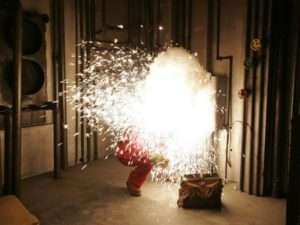If you work with electricity in an industrial setting, you’ve probably heard of an arc flash. Hopefully, you’ve never had the “pleasure” of experiencing one. Depending on the amount of energy you work with, arc flash events can be extremely dangerous. Your company should provide the necessary training to limit your exposure to potential arc flash hazards.
But even with all of that training on prevention, do you know what an arc flash is? After receiving an updated manual every other year with the latest updates on regulations, do your team members still have questions on how arc flashes occur in their specific workplace? These are some of the questions we’ll answer here.
What is an arc flash?

An arc flash is the result of energy that is released rapidly due to a fault between two electrodes. This energy release occurs during short circuit conditions. The flash quickly passes through the gap, or fault. Some of the ways arc flashes can be initiated include:
-
- Accidental contact
- Underrated equipment making a short circuit current possible
- Contamination of insulated surfaces
- Corrosion or deterioration of equipment or parts
The simplest example of an arc flash is when an incandescent light bulb burns out. When the filament inside the bulb breaks, there is an arc that sustains itself across the filament. The filament becomes enveloped in plasma with a bright, blue flash. Most incandescent light bulbs used in the home have a built-in fuse. This fuse exists to prevent a sustained arc flash from blowing fuses in the circuit panel.
While that explanation seems painless, arc flashes can be much more dangerous. Arc flashes occur in larger equipment can often expel large amounts of lethal energy. The arc itself can cause an ionization of the air and arc flash temperatures can reach as high as 30,000 degrees Fahrenheit. In case you were wondering, a temperature this significant is hotter than the surface of the sun. These temperatures can leave someone’s skin severely burned after only fractions of a second. Even if a person is standing at a significant distance from the “event”, they will still feel the radiant heat and see the flash of light. Primary Protective Equipment (PPE) becomes necessary in these conditions.
Industries that face potential arc flash hazards
The majority of workers go to work everyday and do not have to worry about these hazards. There are others that work closely with equipment that presents the potential for arc flashes. The industries that are most likely to face potential arc flash hazards include:
- Construction
- Manufacturing
- Utilities
The highest number of nonfatal electrical injuries occurs in construction, followed by manufacturing. In both industries, the leading cause of injury is electrical burns. Workers suffer these burns as a result of being located closely to the arc flash event when it happens. The extreme temperatures from the flash can still cause near fatal burns; regardless of FR clothing.
In all other industries, the leading cause of injury is electric shock. Electric shock occurs when a worker is in close enough proximity to feel the explosion of sound, heat and energy from the arc source. If a worker is located closely enough to the source, they could launch dozens of feet through the air by the blast of energy. From utility workers and machine operators to employees working in telecommunications and heavy industry, anyone that works near electrical equipment is at risk for arc flash exposure.
If your team is at risk for arc flash exposure, what are some of the precautions your company takes to improve safety? If you’re wondering if your employees are in the right protective equipment, contact us. We’d be happy to talk to you about what you’re currently doing to promote safety in your workplace.

Topics: Flame Resistant

